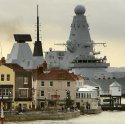The prototype AW 159 Lynx Wildcat (FLynx in case you were wondering) has made it's first flight at Yeovil:
from the website:
The maiden flight of the AW159, which will be known as Lynx Wildcat in UK military service, marks a major milestone in the development of this new six-ton multi-role military helicopter, 62 of which have been ordered by the UK Ministry of Defence for the Army and Royal Navy, to perform both land and maritime missions. The first aircraft will be delivered in 2011 with the aircraft becoming fully operational with the Army in 2014 and the Royal Navy in 2015. The British Army’s AW159 Lynx Wildcat will perform a wide range of tasks on the battlefield including reconnaissance, command and control, transportation of troops and materiel, and the provision of force protection. The Royal Navy variant will provide an agile maritime capability providing anti-surface warfare capability and force protection and will operate in support of amphibious operations and be an important element in defending ships against surface threats. There will be a high degree of commonality between the Army and Royal Navy helicopters that will mean that an aircraft can switch roles easily, principally through the changing of role equipment. The AW159 is powered by two new generation CTS800 engines, each capable of continuously producing 1281 shp giving the aircraft exceptional hot and high performance. The aircraft has an all up mass of 5790 kg with a built in capability to increase that to 6250 kg. The cockpit includes a fully integrated display system utilising four 10x8 inch primary displays. Sensors include a nose mounted IR/TV imager with built in laser designator and for the maritime variant the Selex Galileo 7400E 360 degree active array radar. The AW159 also has a comprehensive integrated defensive aids suite comprising a missile warning system, radar warning receivers and a countermeasures dispensing system. Additionally the AW159 will e capable of carrying a range of weapons including machine guns, torpedoes, depth charges and the Future Anti-Surface Guided Weapon (FASGW). The AW159 programme for the UK MoD continues to be on time and on budget and was the first major project to be awarded under the Strategic Partnering Arrangement signed by the UK Ministry of Defence and AgustaWestland in June 2006. AgustaWestland has also signed partnering agreements with a number of key supplier on the AW159 programme including Selex Galileo, a Finmeccanica company; GKN Aerospace, LHTEC – a partnership between Rolls-Royce and Honeywell, General Dynamics UK, Thales UK and GE Aviation.
from the website:
The maiden flight of the AW159, which will be known as Lynx Wildcat in UK military service, marks a major milestone in the development of this new six-ton multi-role military helicopter, 62 of which have been ordered by the UK Ministry of Defence for the Army and Royal Navy, to perform both land and maritime missions. The first aircraft will be delivered in 2011 with the aircraft becoming fully operational with the Army in 2014 and the Royal Navy in 2015. The British Army’s AW159 Lynx Wildcat will perform a wide range of tasks on the battlefield including reconnaissance, command and control, transportation of troops and materiel, and the provision of force protection. The Royal Navy variant will provide an agile maritime capability providing anti-surface warfare capability and force protection and will operate in support of amphibious operations and be an important element in defending ships against surface threats. There will be a high degree of commonality between the Army and Royal Navy helicopters that will mean that an aircraft can switch roles easily, principally through the changing of role equipment. The AW159 is powered by two new generation CTS800 engines, each capable of continuously producing 1281 shp giving the aircraft exceptional hot and high performance. The aircraft has an all up mass of 5790 kg with a built in capability to increase that to 6250 kg. The cockpit includes a fully integrated display system utilising four 10x8 inch primary displays. Sensors include a nose mounted IR/TV imager with built in laser designator and for the maritime variant the Selex Galileo 7400E 360 degree active array radar. The AW159 also has a comprehensive integrated defensive aids suite comprising a missile warning system, radar warning receivers and a countermeasures dispensing system. Additionally the AW159 will e capable of carrying a range of weapons including machine guns, torpedoes, depth charges and the Future Anti-Surface Guided Weapon (FASGW). The AW159 programme for the UK MoD continues to be on time and on budget and was the first major project to be awarded under the Strategic Partnering Arrangement signed by the UK Ministry of Defence and AgustaWestland in June 2006. AgustaWestland has also signed partnering agreements with a number of key supplier on the AW159 programme including Selex Galileo, a Finmeccanica company; GKN Aerospace, LHTEC – a partnership between Rolls-Royce and Honeywell, General Dynamics UK, Thales UK and GE Aviation.
Last edited:




